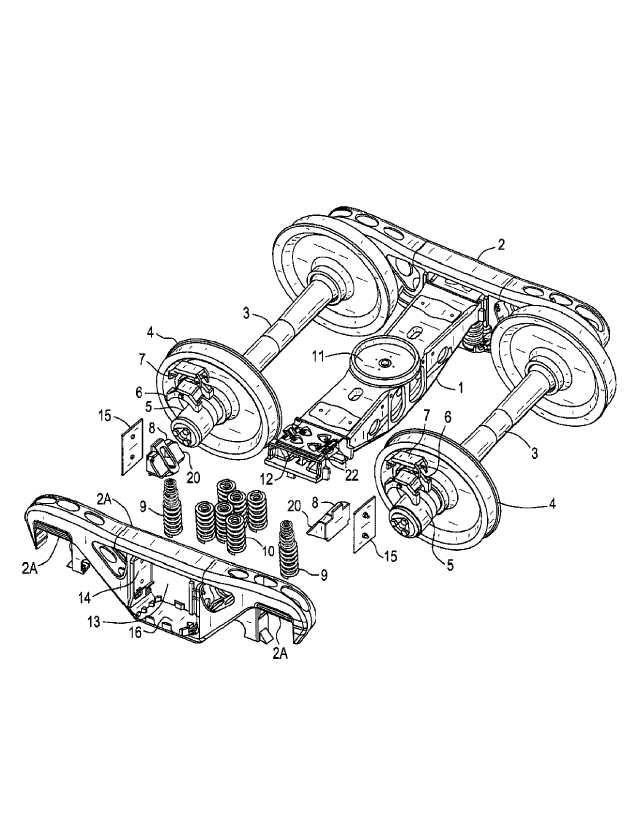Some of the information on this Web page has been provided by external sources. The Government of Canada is not responsible for the accuracy, reliability or currency of the information supplied by external sources. Users wishing to rely upon this information should consult directly with the source of the information. Content provided by external sources is not subject to official languages, privacy and accessibility requirements.
Any discrepancies in the text and image of the Claims and Abstract are due to differing posting times. Text of the Claims and Abstract are posted:
| (12) Patent: | (11) CA 2995792 |
|---|---|
| (54) English Title: | RAILWAY CAR TRUCK FRICTION SHOE |
| (54) French Title: | SABOT DE FRICTION DESTINE A UN WAGON |
| Status: | Granted |
| (51) International Patent Classification (IPC): |
|
|---|---|
| (72) Inventors : |
|
| (73) Owners : |
|
| (71) Applicants : |
|
| (74) Agent: | GOWLING WLG (CANADA) LLP |
| (74) Associate agent: | |
| (45) Issued: | 2020-03-24 |
| (22) Filed Date: | 2018-02-21 |
| (41) Open to Public Inspection: | 2018-09-08 |
| Examination requested: | 2018-02-21 |
| Availability of licence: | N/A |
| (25) Language of filing: | English |
| Patent Cooperation Treaty (PCT): | No |
|---|
| (30) Application Priority Data: | ||||||
|---|---|---|---|---|---|---|
|
A friction shoe for a railway car truck is provided. The railway truck comprises two parallel side frames, a suspension spring assembly supported by the side frames, and a bolster transversely mounted between the side frames and supported by the suspension spring assembly. Each side frame has at least one vertical support face,and the bolster has at least one sloped support face. The friction shoe comprises a bottom base engaging and supported by a pair of support springs, and a sloped wall engaging the sloped support face of the bolster. The bottom base includes a cylindrical spring lug that has a center opening that extends through the spring lug. The bottom surface of the spring lug is flat and smooth and is designed to engage with and provides the ability to use an additional concentrically nested support spring. The additional spring increases the force between the vertical support face of the wedge and the vertical wear plate of the side frame.
Linvention concerne un sabot de friction pour wagon. Le wagon comprend de cadres latéraux parallèles, un bloc-ressorts de suspension soutenu par les cadres latéraux et une traverse installée perpendiculairement entre les cadres latéraux et soutenue par le bloc-ressorts de suspension. Chaque cadre latéral dispose dau moins une paroi de support verticale, et la traverse présente au moins une paroi de support en pente. Le sabot de friction comprend une base montée connectée à une paire de ressorts de suspension, qui la supportent, et une paroi en pente qui se joint à la paroi de support en pente de la traverse. La base comprend un téton de ressort cylindrique comprenant une ouverture centrale qui le traverse. La surface inférieure du téton de ressort est plate et lisse, et conçue pour se joindre à un ressort de support supplémentaire concentrique et lutiliser. Le ressort supplémentaire augmente la force entre la paroi de support verticale du coin et la plaque dusure verticale du cadre latéral.
Note: Claims are shown in the official language in which they were submitted.
Note: Descriptions are shown in the official language in which they were submitted.

For a clearer understanding of the status of the application/patent presented on this page, the site Disclaimer , as well as the definitions for Patent , Administrative Status , Maintenance Fee and Payment History should be consulted.
| Title | Date |
|---|---|
| Forecasted Issue Date | 2020-03-24 |
| (22) Filed | 2018-02-21 |
| Examination Requested | 2018-02-21 |
| (41) Open to Public Inspection | 2018-09-08 |
| (45) Issued | 2020-03-24 |
There is no abandonment history.
Last Payment of $277.00 was received on 2024-01-23
Upcoming maintenance fee amounts
| Description | Date | Amount |
|---|---|---|
| Next Payment if standard fee | 2025-02-21 | $277.00 |
| Next Payment if small entity fee | 2025-02-21 | $100.00 |
Note : If the full payment has not been received on or before the date indicated, a further fee may be required which may be one of the following
Patent fees are adjusted on the 1st of January every year. The amounts above are the current amounts if received by December 31 of the current year.
Please refer to the CIPO
Patent Fees
web page to see all current fee amounts.
| Fee Type | Anniversary Year | Due Date | Amount Paid | Paid Date |
|---|---|---|---|---|
| Request for Examination | $800.00 | 2018-02-21 | ||
| Registration of a document - section 124 | $100.00 | 2018-02-21 | ||
| Application Fee | $400.00 | 2018-02-21 | ||
| Final Fee | 2020-04-01 | $300.00 | 2020-01-15 | |
| Maintenance Fee - Application - New Act | 2 | 2020-02-21 | $100.00 | 2020-01-22 |
| Maintenance Fee - Patent - New Act | 3 | 2021-02-22 | $100.00 | 2021-01-21 |
| Maintenance Fee - Patent - New Act | 4 | 2022-02-21 | $100.00 | 2022-01-19 |
| Maintenance Fee - Patent - New Act | 5 | 2023-02-21 | $210.51 | 2023-01-23 |
| Maintenance Fee - Patent - New Act | 6 | 2024-02-21 | $277.00 | 2024-01-23 |
Note: Records showing the ownership history in alphabetical order.
| Current Owners on Record |
|---|
| AMSTED RAIL COMPANY, INC. |
| Past Owners on Record |
|---|
| None |